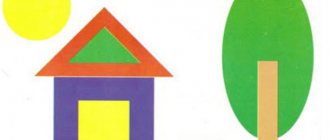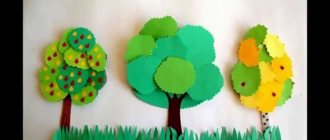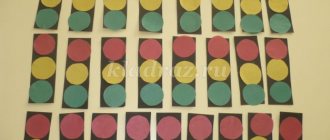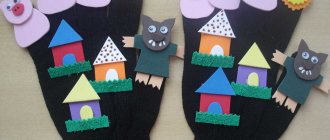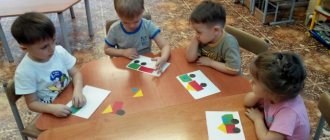GCD modeling in the middle group theme "Fish"
GCD Artistic and aesthetic development. Modeling
Middle group
Theme: Fish
Conducted by a teacher
Sarycheva Lyudmila Viktorovna
Goal: to develop in preschoolers the ability to create the image of a fish using modeling.
Visual tasks: teach children to correctly convey the structure of a fish’s body, proportions of parts, shape, size; develop coordination in the eye-hand system, synchronize the work of both hands.
Technical tasks: learn to divide a block of plasticine into parts; continue to teach children to pinch and pull plasticine away from the main shape (ventral and pectoral fins), to work with stacks (notch, cut plasticine); improve techniques: rolling, unrolling, smoothing.
Educational objectives: to cultivate independence and accuracy in work in preschoolers.
Preliminary work: examination of pictures depicting sea and freshwater fish, game “Loto. Inhabitants of reservoirs”, integration of educational areas: cognitive development, speech development, artistic and aesthetic (drawing), reading the book “To Little Why About the Sea”, riddles, coloring pages “Magic Fishes”, p/i “The Sea Is Worried”, p/i “ Pike and fish”, laying out fish from geometric shapes, “Tangram”, “Fold a square” with the aim of laying out pictures “Underwater World”.
Demonstration material: a large toy fish, a flat fish “Sazan Ivanovich”, on whatman paper there is an image of a lake (“School for young fry”) with algae (desks for fry), technological maps depicting the sequence of actions for creating elements.
1 Organizational part.
Guys, guess the riddle.
Wherever we want, we sail there.
The river is our home, we live in it... (Pisces)
I'll tell you a fabulous story about a fish. In a clear blue lake, next to green algae, lived a good old and wise fish. And the fish's name was Sazan Ivanovich. He had seen a lot in his time, he knew a lot. And Sazan Ivanovich decided to open a school for small fish - fry, in order to teach them wisdom. I wrote an advertisement in the lake newspaper and put up a sign with the inscription “School for Young Fry.” He waited a long time for the young students. He swam to the shore, swam far into the middle, but still didn’t wait. I was upset. Sazan Ivanovich really wanted to tell the kids important and necessary secrets...
Guys, I'm very sorry for the fish teacher. Do you want to help a kind and smart fish? But how can we help Sazan Ivanovich? Right. We will sculpt little fish and students will appear in the “School of Young Fry”.
2. Main part.
Look at the fish toy. Tell me, what parts does the body of a fish consist of?
Sensory examination. The teacher asks leading questions, helping the child to independently identify and compare the main parts and some details.
Finger gymnastics.
| A small fish swims along the river | put your palms together and tilt them to the sides |
| The little fish beats its tail | Stretch your arms forward and alternately wave your hands up and down, imitating waves or a ponytail. |
Teacher: - To start sculpting a fish, you need to divide a block of plasticine into parts. Visually divide it in half and draw a line with a stack. Then we visually divide one half in half again and cut it off - this is the “secret”. We put the “secret” in the upper right corner of the board. From a large piece we will sculpt an ovoid - a body along with a head and tail.
The teacher clarifies how the children will sculpt the ovoid and asks them to accompany the story with hand movements. Then he shows the children how to cut the narrowed part of the ovoid in stacks and move the two resulting halves to the sides - this is the tail.
The teacher calls the child for a demonstration. - Alena, show how you cut the narrowed part of the ovoid and move the cut parts to the sides (show on the finished model).
The teacher reinforces all explanations and demonstrations with mnemonic diagrams.
Teacher: - To make the tail flat and beautiful, we flatten the cut parts and cut them from the inside. Now we make the ventral fins, pinching them on both sides of the body. Nastya, how will you make the dorsal fin (child’s explanation). Do any of you have another option? (child's explanation)
Teacher: - That's right, the dorsal fin can be made by pinching, or it can be done in a constructive way: a small ovoid, flattened and stuck to the top of our fish. To do this, we use the “secret”. We coat the joint and smooth out all the irregularities.
The teacher offers to sculpt small fish. Turns on the music. During modeling, the teacher approaches the children, providing assistance and reminding them of the need to use a wet wipe. Each time he clarifies how the child will do this or that part of the craft. Let's release your fry into the lake. Let's put them at algae desks.
3. Analysis.
The teacher asks the children to tell about the most beautiful fish. He asks why they like her? Notes expressive eyes, a flat beautiful ponytail and a voluminous body, etc. He asks what the names of the fish they sculpted are, and how the dorsal fin was made.
- Guys, hear the bell ringing. A lesson begins at the School of Young Fry. Let's not disturb them.
The P/I “Pike and fry” is being held.
Children tidy up their workspaces, put boards and plasticine back in place, and place napkins to dry.
DIY goldfish made from plasticine
All children know what a fish should be like - it is a swimming animal.
She has a tail and fins that help her swim. It is better to sculpt a goldfish from yellow or bright orange plasticine. What to prepare for sculpting a river inhabitant:
- Yellow plasticine;
- Stack and toothpick.
Stages of sculpting a goldfish
Bright yellow plasticine is the main material for work. If you have a golden tint in your set (sometimes there are such), then it is better to use it. Then you will have a truly fabulous beauty who will fulfill all your desires. Having a suitable block at hand, start sculpting.
Next, prepare a large volumetric blank for the body and flat parts for the fins and tail. The latter can be obtained by simply pressing the pieces with your fingers and stretching them in different directions. First we need to give the desired shape, and then we will modify the details and give them texture. There will be no need to make any exact copies or small details.
Next, give the resulting flat pieces a more suitable shape, more like triangles, so that they become fins. In real fish they are very thin, almost weightless. Thanks to them, she feels comfortable in the water and moves quickly.
The body that we prepared earlier needs to be slightly modified using a toothpick. Use the sharp end to outline the head, and also draw a line of scales that must cover the body of the fish. You need to make scarlet lips from plasticine on your head. And also show (squeeze) the eyes. The body shape is already given - a simple oval.
Glue the eyes by simply filling the previously prepared holes. We will need to take drops of black and white plasticine.
Apply grooves to the fins and tail using a toothpick. To make the ponytail voluminous and multi-layered, it is better to make it in two parts. The side fins of fish are usually small, so make them narrow and oblong.
Collect the golden figurine. Glue the puffy tail to the back, folding in the puffy triangular pieces. Glue the oblong main fin on top. And also add side ones, through which the fish swims.
We received a real sorceress in the form of a plasticine craft. Now the fish can fulfill three wishes of the sculptor. Come up with them together with your child; for sure, he will want to eat something tasty after fruitful work.
And the fulfiller of the wish will be the mother or father, who should encourage the creative achievements of their children. Praise and reward inspire you and push you to new creative achievements.
Cockerel fish - step-by-step modeling
Summary of the lesson on modeling “the ship sets sail”
We show you step by step how to make another fish – the Cockerel.
You will need a piece of plasticine and a plastic knife.
Make a ball out of plasticine.
Roll a sausage out of a ball. Round the edges of the sausage, then flatten the figure a little. Step back a little from the edge and use a knife to make a vertical cut. You have outlined the head.
Make four small balls of different sizes. Mash them with the pad of your index finger so that you get circles and stick them on top of the fish’s body. The dorsal fin is ready. Roll a larger ball, knead it, cut off half and form the lower fin. Attach it from below to the body of the fish.
Now use the end of the knife to draw stripes on the upper and lower fin and tail.
Using a knife, make numerous indentations on the body of the fish that imitate scales.
All that remains is to mold the eyes and mouth into a tiny bow.
The fish is ready.
Step-by-step photo lesson:
Summary of the direct educational activity “Dymkovo toy” (middle group)
The fish can be made of plasticine of any color. One option is enough. You will also need rhinestones or beads to make shiny eyes. The main tool is the stack.
Cut the required amount of plasticine from the block and roll it into a ball.
Draw the ball out into a bullet, then lightly press the rounded piece onto a hard surface to make it flatter. Turn one side into a head, marking it with the same stack.
To create the fins, place small cakes on top and bottom in a row.
Use a stack to create membranes on the fins.
Attach the fish tail to the back, also finishing it with a stack.
Think about how you would like the scales on the fish's body to look. You can stick plasticine on top, placing small dots overlapping. And we suggest simply piercing the soft plasticine with the tip of the stack many times over the entire surface of the craft.
The final touch is the design of the fish’s face. Stick on shiny rhinestone eyes and attach a mouth.
A plasticine fish is ready to surf the waters. Take some water into a children's bucket and put the fish in it. Plasticine does not become limp from water, so such activities can be practiced.
Familiar plasticine fish
? Of course, this is the famous Dory - the sweet but forgetful heroine of the popular cartoon. Now you can make it yourself to create even more exciting adventures!
Conduct a simple modeling master class with your child to develop his fine motor skills, perseverance and accuracy. The result of your joint creativity is a neat figurine that exactly replicates the original from the big screen.
